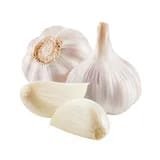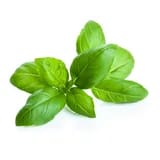Sautéed Shrimp & Polenta
115 reviewsHave you ever thought to pair shrimp with polenta? If not, we thought about it for you, and it's fantastic!

Ingredients
Make sure you have...
Utensils
Stovetop, Frying pan, Pot (small)
recipe

Step 1
If needed, thaw the shrimp. Wash & slice the cherry tomatoes in half.

Step 2
Heat a drizzle of olive oil in a pan, over medium heat. Add the grated garlic & sauté for 30 seconds, stirring.
Step 3
Add the cherry tomates & cook for 2 min.



Step 4
Meanwhile, prepare the polenta according to package instructions. Once cooked through, add the grated parmesan cheese & stir to combine. Re-season to taste.

Step 5
Add the shrimp & a splash of water to the pan. Season with salt & pepper and stir. Cover & leave to simmer for 3-4 min, over low heat.

Step 6
Serve the polenta in a bowl with the sautéed shrimp & tomatoes. Top with fresh basil, if you have some & re-season to taste. Enjoy !
Personal notes
Add your own flavor!
Nutrition facts
Average estimated amount for one serving
| Energy | 390 cal. |
| Fat | 8 g |
| Carbohydrates | 52 g |
| Protein | 25 g |
| Fiber | 3 g |
Values are based on an average estimate for one serving. All nutrition information presented on Jow is intended for informational purposes only. If you have any concerns or questions about your health, please consult with a health-care professional.
On average, one serving of the recipe "Sautéed Shrimp & Polenta" contains 390 Energy, 8 g of Fat, 52 g of Carbohydrates, 25 g of Protein, 3 g of Fiber.
Price per portion
| € | Nos recettes à -2 € par portion |
| €€ | Nos recettes entre 2 € et 4 € par portion |
| €€€ | Nos recettes à +4 € par portion |
Please note, the price above is dependent on your grocer and the available products in the grocery store you chose.
Scores


A Nutri-score
The Nutri-score is an indicator intended for understanding nutritional information. Recipes or products are classified from A to E according to their food composition to promote (fiber, proteins, fruits, vegetables, legumes, etc.) and foods to limit (energy, saturated fatty acids, sugars, salt, etc.).
C Green-score
The Green-score is an indicator representing the environmental impact of food products. The recipes or products are classified from A+ to F. It takes into account several factors on the pollution of air, water, oceans, soil, as well as the impacts on the biosphere. These impacts are studied throughout the product life cycle.
Retrieving reviews...


